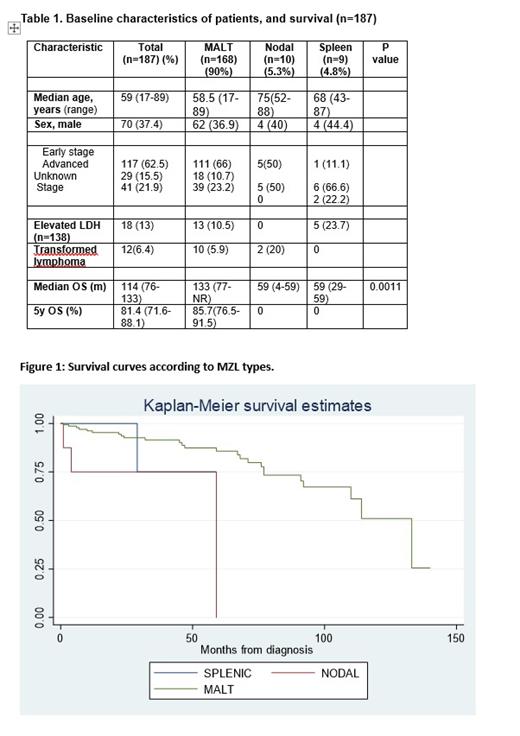Background
Marginal zone lymphoma (MZL) represents a heterogeneous subgroup, classified as extranodal, splenic and nodal lymphoma. Extranodal cases, also termed mucosa-associated lymphoid tissue (MALT), account for 70% of MZLs. Splenic marginal zone B-cell lymphoma (SMZL) accounts for <2% of all NHL. There is no data about marginal zone lymphoma in Latin American patients.
Methods
We evaluated retrospectively all patients diagnosed with marginal zone lymphoma at the National Cancer Institute from 2010 to 2019. Baseline characteristics, treatments and survival were retrieved from medical records. Kaplan Meier method was used to analyze the overall survival. The estimate of the survival curves was performed by the Kaplan-Meier method, and the differences were computed by the log-rank test. The Cox proportional hazard models were used to identify predictors of survival of MZL. A level of p <0.05 was considered for a statistical significance.
Results
During the study period 2010-2019, 4437 patients with B-cell non-Hodgkin lymphoma were evaluated at the INEN, 187 of them were marginal zone lymphomas, representing 4.2% of all cases. The most frequent marginal zone lymphoma was MALT, followed by nodal and splenic lymphoma with 89.8%, 5.3% and 4.8% of cases, respectively. The median age for the entire cohort was 59 years (range 17-89). The median age for the MALT, nodal and splenic MZL cohort were 58.5 years (range 17-89), 75 years (range 52-88), 68 years (range 43-87), respectively. 37.4% were male for the entire cohort, and 37%, 40%, 44% for the MALT, nodal and splenic MZL group. Elevated LDH was seen in 13% of the entire cohort and in 11% and 24% of the MALT and splenic MZL group. Transformed lymphoma was reported in 6.4% of the entire cohort, but in the 20% of nodal MZL and no one case of the splenic MZL. More data you can see in the table 1. The most frequent primary site locations for MALT lymphoma were gastric, ocular adnexal, parotid gland, cutaneous, intestinal and CNS with 36%, 30%, 7%, 5%, 5% and 5%, respectively. The median overall survival was 114 months (IQR 76-133) for the entire cohort and 133 months, 59 and 59 months for the MALT, nodal MZL, and splenic MZL, respectively (p=0.0011), see the figure 1. The 5-year OS was 81.4% (95% CI, 71.6-88.1) for the entire cohort and 85.7% (95% CI, 76.5-91.5) for the MALT lymphoma group. No one patients were alive at 5 years in both nodal and splenic lymphoma groups.
Conclusion
Marginal zone lymphoma is a relatively rare type of B-cell lymphoma. The most frequent type is MALT lymphoma, followed by nodal MZL. The median age for the entire group was 59 years, however patients with nodal MZL were older with a median age of 75 years. Transformed lymphoma was present in 6% of the entire cohort and in the 20% of the nodal MZL. Gastric, ocular adnexal and parotid gland were the most common primary site of MALT lymphoma. MALT lymphoma had long survival, but nodal and splenic MZL had shorter survival with no one surviving 5 years from diagnosis.
Disclosures
No relevant conflicts of interest to declare.


This feature is available to Subscribers Only
Sign In or Create an Account Close Modal